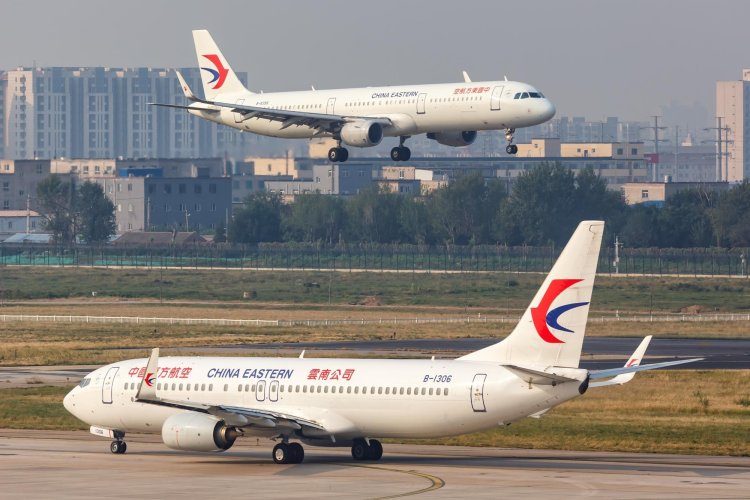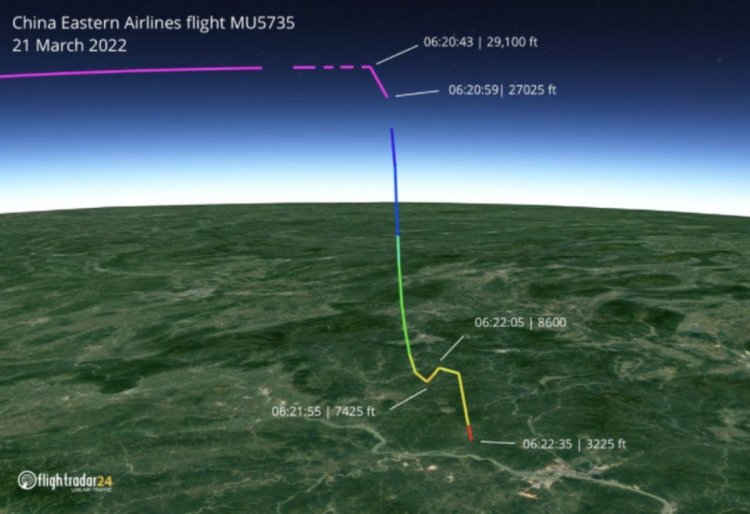The Non-Buoyant Boeings: Why Boeing Planes Are Falling From The Sky?
Flight MU5735 took off from the southwestern city of Kunming and was bound to the capital of Guangdong, Guangzhou, an area bordering Hong Kong. At around 11:00 AM IST, the flight was found cruising at an altitude of 29,100 feet, according to the data by FlightRadar24.

On March 21, 2022, a China Eastern Airlines flight MU5735, cruising at a height of roughly 29,000 feet plummeted into the ground due to reasons unknown resulting in the death of a total of 132 people – 123 passengers and 9 crew – on board.
The China Eastern flight was a Boeing 737-800 and was travelling from Kunming, capital of Yunnan, to Guangzhou. The flight was minutes away from its destination when it dropped from the sky and crashed into a mountainside in the province of Guangxi.
https://twitter.com/RoINTEL/status/1505878442889388043
https://twitter.com/PBNS_India/status/1505858435296141315
Latest Development
Hampered by difficult terrain and erratic weather, the rescue operation kicked off but resulted in nil success as the rescuers found no survivors from the jet so far. While the rescuers had found the first black box – a flight recorder installed in an aircraft – the second black box was found on Sunday, March 27, 2022.
https://twitter.com/asianewsteam/status/1507957932339597315
While the first black box recorded the activities in the cockpit, including the voice of the pilots, the second black recorded the altitude and speed of the flight. Both the black boxes are currently under investigation.
What Actually Happened?
Flight MU5735 took off from the southwestern city of Kunming and was bound to the capital of Guangdong, Guangzhou, an area bordering Hong Kong. At around 11:00 AM IST, the flight was found cruising at an altitude of 29,100 feet, according to the data by FlightRadar24.

Soon after, roughly a minute and a half later, the plane’s altitude plunged to 7,425 feet. As per the last data recorded after 30 seconds, the plane had reached an altitude of 3,225 feet before finally crashing into the ground.
Boeing and Crashes
Boeing is one of the most prominent aircraft manufacturers. Their reputation in the industry had enjoyed a top-shelf position. However, the aircraft instilled a blow in the reputation when on October 29, 2018, Indonesian airline, Lion Air, flight 610, met with a fatal crash minutes after taking off from the runaway. The crash took the lives of all 189 passengers flying in the aircraft, which was a Boeing 737 Max.
Less than six months later, on March 10, 2019, another Boeing 737 Max, belonging to Ethiopian Airlines took the lives of all 157 passengers on board after it crashed within six minutes of taking off. The flight took off from Addis Ababa and was bound for Nairobi. After this incident, the Boeing 737 Max was grounded till November 2020, after which, it again got clearance to fly.
Boeing 737 Max
Boeing 737 Max was the fourth-generation aircraft of the 737 family and was a successor to the Boeing 737-800, the place which took the lives of 132 Chinese nationals on March 21, 2022. The flight was one of the highest-selling aircraft manufactured by the company and soared the stock prices of Boeing.
Boeing 737 Max was Boeing’s defending candidate against the highly fuel-efficient A320neo, manufactured by Boeing’s biggest competitor in the world, Airbus. Seeing the success A320neo was garnering, Boeing, instead of coming up with a technological turnover, decided to make tweaks to the already flying framework of the Boeing 737-800.
The Fatal Mistake
Boeing decided to make the existing Boeing 737 aircraft more fuel-efficient by changing the engines of the aircraft, repositioning them on the wings, and selling it under a new moniker, the Boeing 737 Max. The engines, however, did not align with the body and were a little too heavy for the aircraft due to the repositioning.
The heavy engines, in theory, would have tipped off the nose of the aircraft upwards, causing the aircraft to stall. To counter this issue, Boeing came up with a software update for the Boeing 737 Max known as MCAS (Manoeuvring Characteristics Augmentation System).
MCAS
MCAS was a flight stabilizing system that forced the nose of the aircraft downward. MCAS was a quick solution to a problem that would have cost Boeing loads of money and time to solve. With heavy engines and structural flaws, MCAS seemed to be doing the trick and hence was connected to the Angle of Attack (AoA) sensor. The Angle of Attack sensors observes the deviation of the angle of the plane from the horizontal.
One of the major red flags in the technology was that despite the Boeing 737 Max having two Angle of Attack sensors on each side of the aircraft, the MCAS was only connected to one. In case, that one AoA sensor went faulty due to any technical or physical reason, the MCAS would get activated and force the nose of the plane downward.
Another red flag was that Boeing installed MCAS, connected to just one AoA sensor, on all their 737 Max, they did not notify the pilots of the new system in order to save the cost of additional pilot training. These red flags combined resulted in the death of a total of 346 people.
The Route Ahead
After this, all Boeing 737 Max airplanes were grounded before flying again in December 2020. The Boeing 737-800 that crashed in China have resulted in the same fate as all flights are tied to a heavy and burgeoning metaphorical anchor that is unlikely to be lifted soon.
The reason for the most recent crash of the Boeing 737-800 is yet unknown. However, now that the investigators on the case have acquired both the black boxes, concrete insights into why the plane nosedived to the ground in minutes can be obtained. The situation can tip off in any direction – good, bad, or ugly – depending on the information that is retrieved from the black boxes.










































